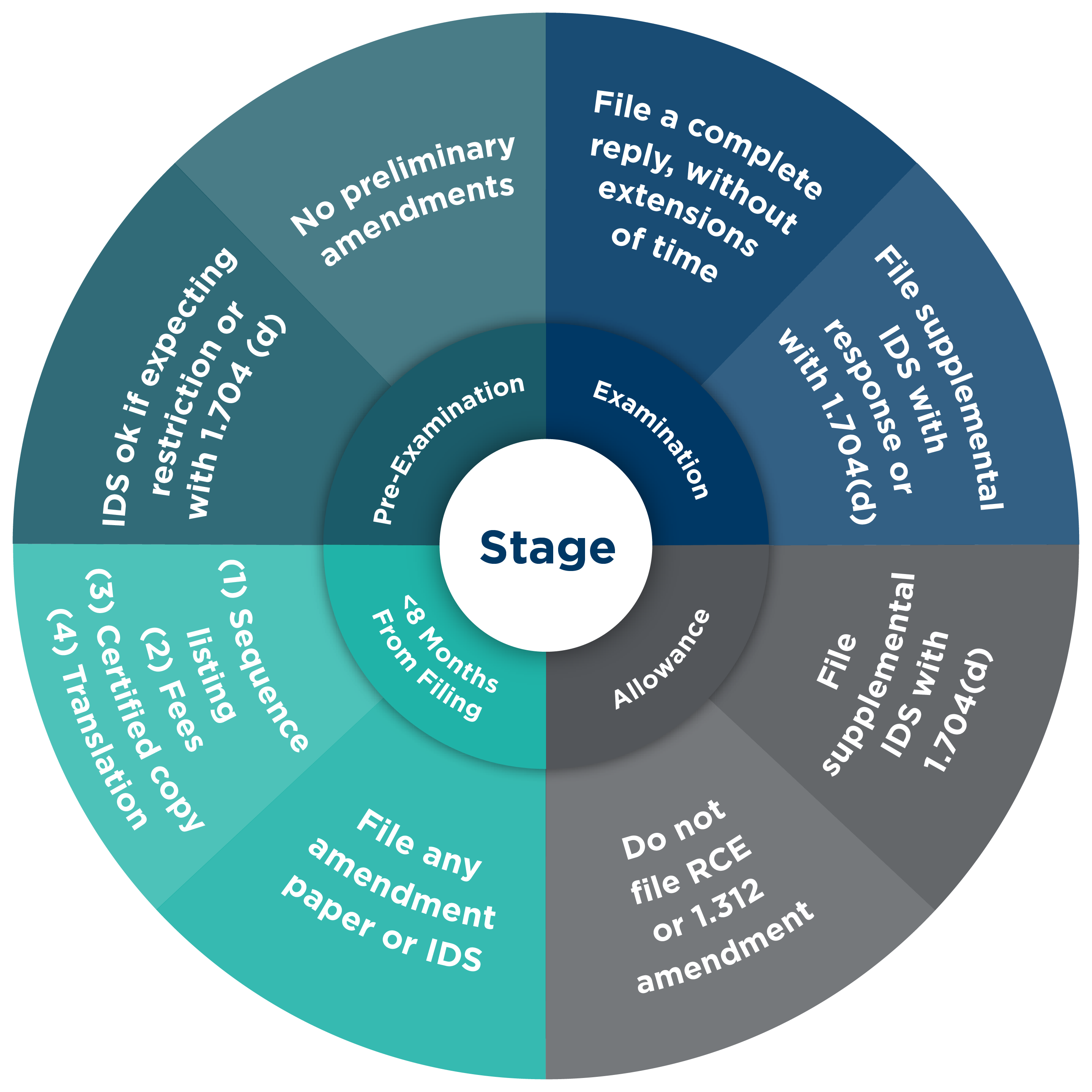Practical Guidelines for Avoiding Patent Term Adjustment Penalty

The duty to disclose required by 37 CFR § 1.56 is a constant weight on patent practitioners and applicants to cite references via an Information Disclosure Statement (IDS). The indiscriminate or reflexive filing of an IDS can, however, result in the accumulation of substantial applicant delay under 37 CFR § 1.704, reducing any potential award of Patent Term Adjustment (PTA) under 37 CFR § 1.703. PTA penalty accumulated as a result of IDS filings can be minimized by following two simple guidelines. First, file the initial IDS and any supplemental IDS (SIDS) at any point before the issuance of the first action on the merits (Restriction Requirement, Non-Final Office Action, Ex Parte Quayle action, or Notice of Allowance). And second, following the mailing of the first action on the merits, only file an IDS with a complete response to a pending action, or by satisfying the exception under 37 CFR § 1.704(d).
File an application in condition for examination, or provide any missing pieces within eight months from the filing date or commencement of the national stage. Failure to provide an application in condition for examination within eight months from filing the application or the commencement of the national stage accumulates applicant delay (37 CFR § 1.704(c)(13)). The requirements for placing an application in condition for examination fall into three groups (1.704(f)). First, an application in condition for examination includes at least one claim and an abstract, a specification, and drawings, where the application papers and drawings satisfy the formatting requirements of 37 CFR § 1.52 (margins, font, orientation, etc., for papers) and 1.84 (requirements for drawings). The majority of applications satisfy these requirements when the application is filed.
Second, the inventor’s oath or declaration, or an application data sheet identifying the inventor by their legal name and providing a mailing address and residence address for the inventor, if the residence is different than the mailing address (37 CFR § 1.63(b)). Every application should be filed with an application data sheet providing this information, thus satisfying this requirement.
Third, and the requirements presenting the greatest risk from a PTA penalty perspective, an application in condition for examination includes any fees (filing, search, examination, and application size fees), a sequence listing, a certified copy of a previously filed application, and an English translation of the application. As the first two groups of requirements should be satisfied when the application is filed, this third group of requirements provides an opportunity to inadvertently accumulate applicant penalty if they are not provided to the USPTO within eight months of the filing date of a utility application or the commencement of the national stage. It is recommended to review the application after filing and remedy any deficiencies or provide any omissions within the eight month time period.
Avoid filing a preliminary amendment or paper, more than eight months after the filing date or commencement of the national stage and before examination starts. Applicant delay accumulates if a preliminary amendment or paper, such as an IDS, is filed less than one-month before the mailing of the first of a Restriction Requirement or Non-Final Office Action (35 U.S.C. § 132), or a notice of allowance (35 U.S.C. § 151) and “requires the mailing of a supplemental Office action or notice of allowance” (37 CFR § 1.704(c)(6)). Applicant penalty begins accumulating the day after eight months from the filing date or commencement of the national stage to the filing of the preliminary amendment or paper, rather than the time between the initial office action and the supplemental office action. Thus, filing a preliminary paper, such as an IDS or preliminary amendment, after the eight month date risks accumulating substantial applicant delay.
This risk, however, is relatively small for most applications as it requires the USPTO to first mail a Restriction Requirement, Non-Final Office Action, or Notice of Allowance within 30-days of the filing of the IDS or preliminary amendment. And second, the USPTO must then re-issue the Restriction Requirement, Non-Final Office Action, or Notice of Allowance. While the first step is possible, the second step of the USPTO re-issuing the action is much less likely.
Where this risk can be substantially increased is when the applicant is pursuing a narrow scope of claims or a single independent claim, which is unlikely to receive a restriction requirement and instead receive a Non-Final Office Action as the first action. Filing a preliminary amendment or paper in such an application risks falling within the one-month window and is more likely to trigger the mailing of a supplemental action. The risk is also acute when filing a preliminary amendment in an application pursuing broad claims or those with multiple independent claims, as a restriction requirement is more likely to be the first action. Such a filing is likely to trigger the mailing of a supplemental restriction requirement and so should be avoided. Accordingly, filing any IDS prior to the start of examination in an application having broad claims or multiple independent claims is unlikely to accumulate applicant delay even when filed more than eight months from the filing date or commencement of the national stage.
File a complete response to any notice or action. Any reply not considered a complete reply accumulates applicant penalty from the filing date of the incomplete reply until the omission is provided (37 CFR § 1.704(c)(7)). Because the USPTO can take weeks, or even months, to identify the omission and notify the applicant, substantial delay can accumulate if the applicant does not quickly identify and remedy the omission.
Do not file a supplemental reply. Once examination starts, such as by the mailing of a Restriction Requirement or Non-Final Office Action (35 U.S.C. § 132), any supplemental reply filed after a complete reply to the notice or action has been filed, accumulates applicant delay (37 CFR § 1.704(c)(8)). This penalty applies whether or not any actual delay occurs (Gilead Sciences Inc. v. Lee, 778 F.3d 1341 (Fed. Cir. 2015)). Because a common supplemental reply includes a supplemental IDS, once examination begins, a supplemental IDS should only be filed with a complete response to the pending notice or action. The only exception to this would be if the exception under 37 CFR § 1.704(d) applies.
Following a notice of allowance, issue fee payment should be the only response. After the mailing of a notice of allowance, the filing of an amendment under 37 CFR § 1.312 or other paper (37 CFR § 1.704(c)(10)), or a Request for Continued Examination (37 CFR § 1.704(c)(12)), accumulates applicant delay from the mailing date of the notice of allowance to the applicant’s subsequent filing. MPEP § 2732(III)(J) identifies additional filings made after allowance that will accumulate PTA penalty, including: a paper containing a claim for priority or benefit or request to correct priority or benefit information (e.g., a new or supplemental application data sheet filed to correct foreign priority or domestic benefit information), a request for a corrected filing receipt, a certified copy of a priority document, drawings, a letter related to biologic deposits, and a request to change or correct inventorship.
Other papers filed after allowance, however, will not trigger PTA penalty, including: Fee(s) Transmittal (PTOL-85B), power of attorney, change of address, change of status (micro/small/not small entity status), a response to the examiner’s reasons for allowance or a request to correct an error or omission in the “Notice of Allowance” or “Notice of Allowability”, requests for a refund, an inventor’s oath or declaration, and others (see MPEP § 2732(III)(J)). Accordingly, the only substantive action following a notice of allowance should be payment of the issue fee.
Exception to 1.704(c)(6), (8), (10), and (12) for filing Information Disclosure Statements. References first cited in a foreign office action in a related foreign application can be cited in a Supplemental IDS without accumulating applicant delay if
- the Supplemental IDS is the only paper being filed, and
- applicant states that each item of information in the Supplemental IDS was
- “first cited in any communication from a patent office in a counterpart foreign or international application or from the Office,”
- the communication was not received by any inventor, any “attorney or agent who prepares or prosecutes the application”, or any other “person who is substantively involved in the preparation or prosecution of the application and who is associated with the inventor, the applicant, an assignee, or anyone to whom there is an obligation to assign the application” (37 CFR § 1.56(c)), and
- the communication was not received “more than thirty days prior to the filing of the information disclosure statement.”
(37 CFR § 1.704(d)). Accordingly, it is critical to promptly review any new foreign office action for possible newly cited references in the foreign office action.
Do not take extensions of time beyond three months from the mailing date of any notice or action. Applicant delay accumulates when extensions of time are taken to file a response more than three months from the mailing date of any action or notice from the USPTO (37 CFR § 1.704(b)). Representative notices or actions include Notice to File Missing Parts, Notice of Insufficiency, Restriction Requirement, Non-Final Office Action, Final Office Action, Ex Parte Quayle Action, Notice of Allowance, and any other USPTO notice or action. Because a minority of these actions and notices provide a shortened period of reply of only two months (Notice to File Missing Parts, Notice of Insufficiency, and Restriction Requirement), it is recommended not to take any extension of time unless the notice or action provides a shortened period of reply.
Best practices for filing information disclosure statements:
- File an initial IDS by the later of the response to the Missing Parts, no later than three months from the Missing Parts mailing date, or eight months from the filing date or commencement of the national stage.
- Any initial IDS filed more than eight months after the filing date or commencement of the national stage and before the start of examination should only be filed when there is a strong likelihood of receiving a Restriction Requirement as the initial action from the USPTO.
- File any Supplemental IDS prior to the start of prosecution, or with a complete response to any subsequent action, such as a Restriction Requirement, Non-Final Office Action, or Final Office Action.
- Do not file a Supplemental IDS after the mailing of a notice of allowance.
- For any new references first cited in a foreign office action in a related foreign application, file a Supplemental IDS within 30-days of the mailing date of the foreign office action, satisfying the requirements under 1.704(d) and 1.56(c).

